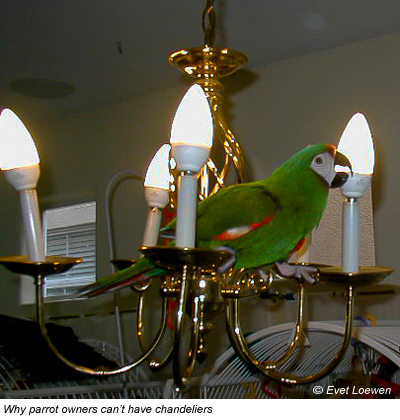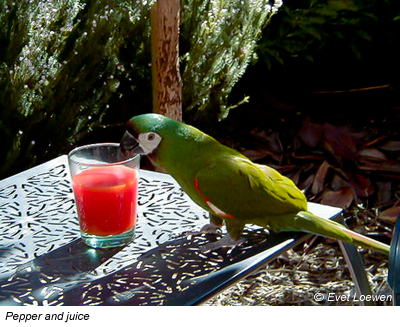How did it all begin? That journey to having Red Bellied Macaws in my life for more than a decade?
It began totally the wrong way. It began the way that 95% of parrot owners decide that they’d like to have a parrot (I made that percentage up, so please don’t get upset if you think it is an inaccurate statement).
My brother, his wife, and two wonderful daughters have had an umbrella cockatoo for 18 years now. Back in 1998, Abigail was a younger umbrella and definitely in charge of the household. Still is, for that matter. A very well socialized and happy cockatoo who is an integral member of the family and gracious to every guest.
In 1998 I visited my brother Collin, his wife Susan, and his two fine daughters, Allyson and Kaitlin, who live in Houston, Texas. One day my brother asked me if I’d like to go to the place where they purchased Abigail. It was a place that only sold birds and bird stuff. I’d never seen a bunch of young parrots all in once place. Of course, I thought they were “adorable”. Especially one little green one with a facial patch that had lines of small feathers, and brown feathers on her cere, who came right up to the side of the cage where she was stashed with a bunch of other juvenile, unweaned severe macaws.
I was immediately intrigued. I had never thought of owning a parrot before. I had no idea what a severe macaw was, where it came from, how it was bred in captivity, what it ate, what it needed to live a good life in captivity, what size cage it needed, what type of veterinarian care it would require. None of that.
It’s not as if I marched up to the counter and said I wanted the bird right then and there. No sirree. I came back to visit about 3 times, thinking about whether it was a good time in my life to take on that type of commitment, simply in terms of cost of purchase.
On the third visit, I came with my sister-in-law. It was the day before I was to leave to return to California. I still wavered. My sister-in-law, seeing how drawn I was to this bird, said “Oh, just get the bird.” So I did. Then, one of Collin’s daughters, Allyson, named the bird “Pepper” because of her red coloring on her carpals and the green body. The name Pepper stuck.

The people at the store told me that the bird was unweaned and sold me some sort of juvenile formula and gave me one of those giant feeding syringes. It was a piece of cake to feed a baby bird, I was informed.
I had to run around and find a veterinarian that would issue a health certificate that night so that I could get Pepper on the plane with me the following day. She did fly in the passenger compartment beneath the seat, probably not the most comforting of ways to begin a new life with a total stranger.
When I arrived back in Silicon Valley with Pepper and rushed her to my house, I knew I had no cage for her at all and the beneath-the-airplane-seat carrier wouldn’t suffice for her even overnight. So, I came in the door, put her in the bathtub and closed the bathroom door since there were several cats in the house, and ran out promptly to a pet store to get a cage. It was a decent sized cage, but since it came from a major chain, was not the best nor as large as she very quickly needed. She had a new place to be that evening, though.
Then, lady luck intervened. A vet tech from a great clinic had been housesitting for my dog and cats. She came to check in, saw poor little Pepper, and said “You know, this bird should get a full checkup by an avian veterinarian. Birds are different and have special needs. You really should take her in to see the veterinarian at our clinic in the next few days.”
So I did. And received a thorough lesson in what needed to be done. Higher quality juvenile formula. More adept instructions on how to feed an unweaned parrot, such as taking great care not to burn the crop by overheating the food. Strict instructions on cleanliness of cage and food and feeding bowls that I follow to this day. And, a diagnosis that Pepper had e. coli, and needed an antibiotic. That was sobering.
After getting tons of instructional materials and what felt like a lecture, I finally told this veterinarian not to worry, that I had had many cats and dogs and could care for a bird just fine, thank you. That must have been very reassuring! How foolish. How arrogant.
So here’s the list of what I did wrong in getting my first bird, and still my most important bird:
(1) Impulse purchase;
(2) No knowledge whatsoever about owning birds, let alone parrots;
(3) Unweaned 12 week old juvenile bird;
(4) No idea how to properly feed an unweaned juvenile parrot;
(5) Not even a cage or decent carrier for this bird to be brought after a long plane ride back to California from Texas;
(6) A full vet check only occurred several days after purchase;
(7) Et cetera, et cetera, et cetera.
Why is a severe macaw important in a chronicle about Red Bellied Macaws?
Because Pepper is a small macaw and an introduction to the idea that small macaws are neat birds. ALL small macaws. After a while, I wanted ALL species of small macaws -- also, perhaps, not the brightest of ideas that I’ve ever had.
I have two good friends on each coast that are the Executive Directors of organizations (Mickaboo on the West Coast, and Phoenix Landing on the East Coast) that re-home parrots who have been given up by their owners, and need foster care until a new home is located. With any luck, neither one of them will find or read this Part 2 of the Red Bellied Macaw chronicles. Because, if they do, I’m not certain either one of them will ever go out to lunch with me again.

Next – Part 3: P. A. S. (i.e., Parrot Acquisition Syndrome)
































